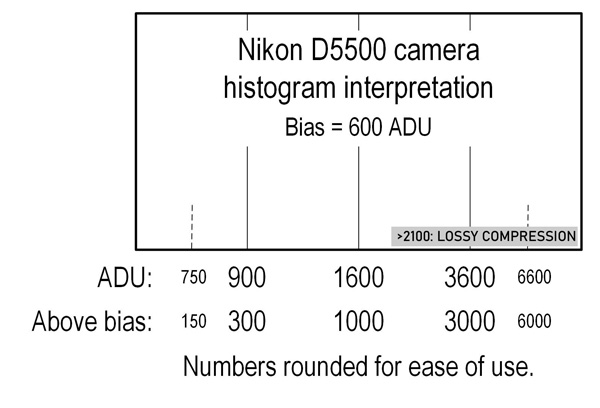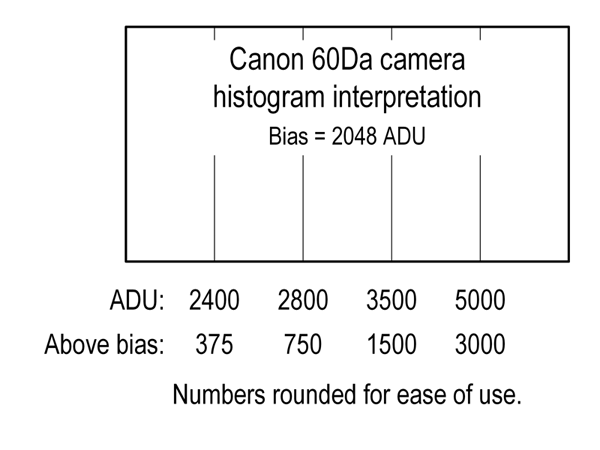2023
March
30
|
AI, computers, and reliability
The media are having a circus, and it seems that all of a sudden, 98% of
what was Artificial Intelligence is no longer called Artificial Intelligence,
and the remaining 2% is considered a public menace.
The menace is not artificial intelligence, it is human stupidity.
Too many people are dead-set on believing things that aren't so,
and they actually squelch me when I explain (for example) how I know
ChatGPT isn't a conscious mind, any more than your MP3 player is a musician.
Here is what I wrote on LinkedIn a couple of days ago:
Permanent link to this entry
Two more farewells
We've already had two obituaries in the Daily Notebook this month.
Let me now mourn two more friends.
Gloria Quarles, the wife of my old friend Rick Quarles, is no longer with us.
I never knew Gloria well (and may have only met her once or twice), but she was obviously
a blessing to Rick and to everyone around her.
Philip Fennell, online friend from Valdosta, died just a couple of days ago.
I am not sure if I ever met him face to face — I haven't been to Valdosta in
years — but he was an intelligent and studious Christian, employed as the manager
of a shoe store.
[Added:] And two more. It took me a while to hear about it, but
Ximena Holcombe, retired schoolteacher in Valdosta, passed away on March 12.
She was the last person I was in contact with from my parents' circle of friends
in their neighborhood (West Park Avenue) in the late 1950s.
And memorial services were held Saturday for Robert Harris, a delightfully
eccentric UGA classics professor from whom I took a course as an undergraduate,
and who died in, I think, December.
May their memory be eternal.
Permanent link to this entry


|
2023
March
26
|
Accidental ETX
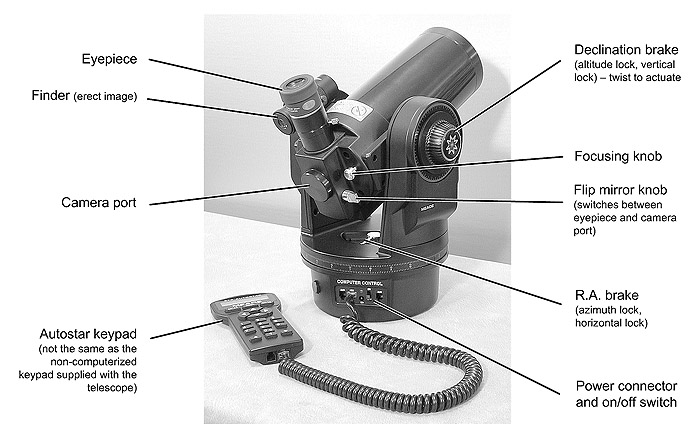
I am unexpectedly the owner of a Meade ETX-90EC telescope (a 9-cm Maksutov-Cassegrain,
f/15, essentially Meade's clone of the Questar).
This happened because of a church charity sale.
This was the big-ticket item at the sale, but even so, priced much lower than its
fair market value (given that they couldn't test it or promise that it worked).
It's the church I belong to, and it had
not sold at the end of the sale, and I couldn't let them just give it to a thrift store.
So far I haven't even finished cleaning it up and testing it. I've confirmed that it is
optically OK and both slewing motors work. I may continue using it as a complete telescope,
or I may take it off its fork mount, put it on a dovetail, and use it on one of my other
mounts, where its focal length is just right for full-face pictures of the sun and moon.
The one in the picture above is not it.
It's the one I had on loan from Meade while writing
How to Use a Computerized Telescope
back in 2001. So I know it fairly well.
Permanent link to this entry
Comparing brightness levels in stops, magnitudes, and decibels
Photographers compare exposures in "stops" or exposure values (EV).
Astronomers compare the brightness of celestial objects in magnitudes (m).
And electrical engineers compare signal levels in decibels (dB).
All three are logarithmic scales, and all three are interconvertible.
Relative, not absolute: I'm talking about relative levels (ratios),
not absolute levels. Magnitudes and decibels are also used another way.
Astronomers give the brightness of a star in magnitudes fainter than the star Vega,
which is defined to be 0.0 (and if it's brighter than Vega, it gets a negative number).
Acousticians give sound levels in dB relative to the threshold of normal human hearing
(thus, a pipe organ can hit 90 dB), and radio engineers give signal levels in dB
relative to one watt (dBW) or one milliwatt (dbm). Those are not what I'm talking about.
Here's how to use those three units to compare to brightness levels (light levels).
Call them a and b. They must be measured linearly, i.e., in a way that
is proportional to the rate at which photons arrive, or the number of photons detected
in a given time. Then:
Stops = log2 a/b
Magnitudes = 2.5 log10 a/b
dB = 10 log10 a/b
It's that simple! From all this it follows that:
1 magnitude = 4 dB
1 magnitude = 1.3 stops
1 stop = 3 dB
So when a camera sensor is rated to have, say, a 30-dB dynamic range, that is 10 stops.
You may have seen a decibel formula using 20 rather than 10, but it's for inferring powers from voltages.
That is, it is used when you want to report a power ratio in decibels, but your measurements are voltages.
The power is proportional to the square of the voltage, and squaring a number doubles its logarithm.
That doesn't apply here.
One last note. Your calculator probably doesn't have log2.
To calculate it:
log2 x = log x / log 2
where the logs on the right are to any base. This is as quick to key in as "log(2,x)" even if your
calculator does have the latter.
Permanent link to this entry


|
2023
March
23
|
Remote Desktop credentials not recognized
Does my name have a backslash in it?
[Revised for conciseness.]
I had a strange Remote Desktop Protocol problem this morning, and the
solution was even stranger. I'm not at liberty to say exactly whose computers
were involved, but I could log on to the remote computer from one laptop and
not from the other.
On the laptop from which I couldn't log on, I got the message:
My username and password were already stored correctly (they worked yesterday!), but typing them in afresh
did not help.
The fix was to give my username as
.\Michael Covington
rather than
Michael Covington
and then it worked. I stored them that way, and it worked.
Why? Because I had a local account named "Michael Covington" on the remote
computer, and a Microsoft Account that listed my name as "Michael Covington"
on the new laptop.
Putting .\ in front of my name tells Windows to use a local account,
and not an account by the same name that is defined in some other place to which
it has access. Normally, that would be a Windows domain, and the syntax is
domainname\username.
The exact rules for this seem to have changed subtly in some very recent Windows update.
Permanent link to this entry


|
2023
March
17
|
A walk through Gemini
Nikon vs. Canon saga continues
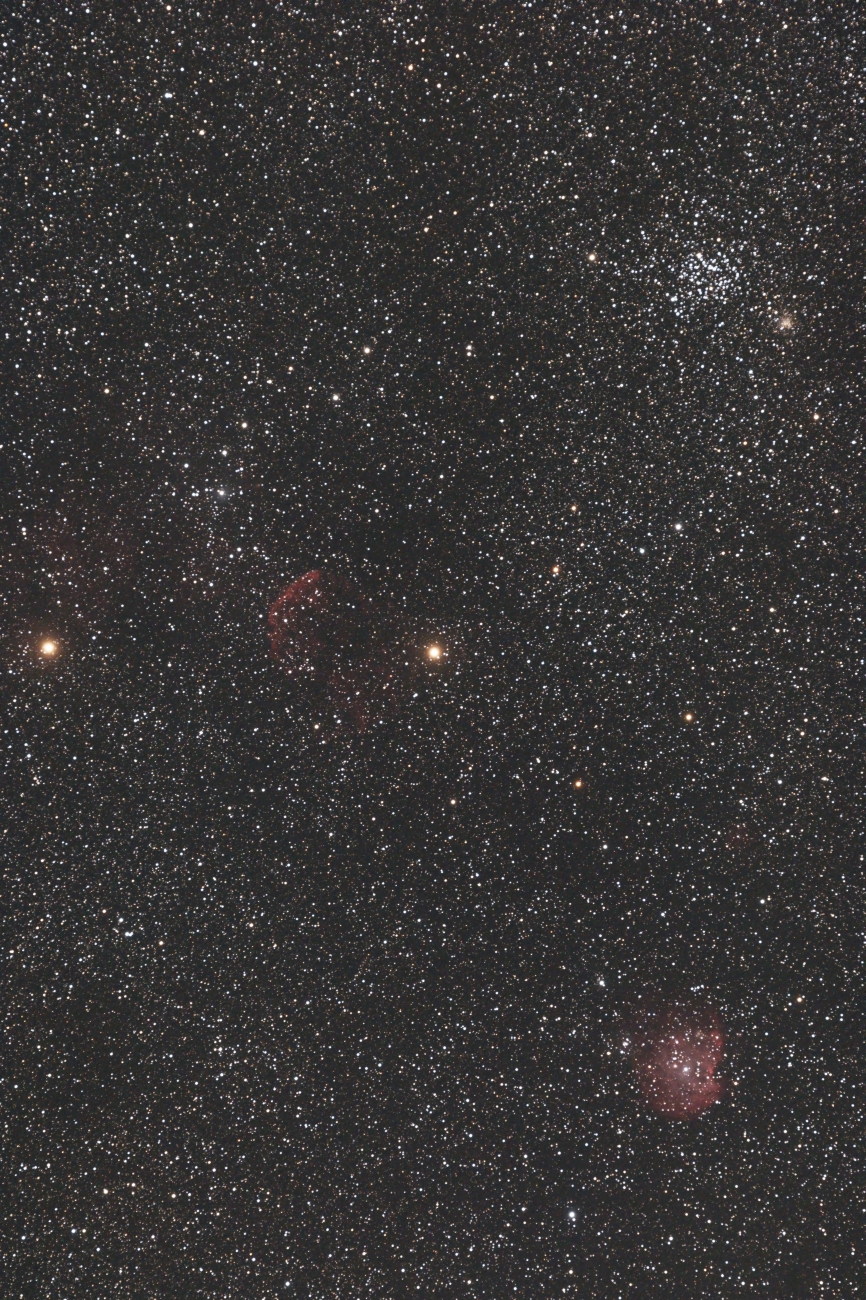
I'm actively using my Canon 60Da (vintage 2012) again, to compare its performance to the
Nikon D5500 I've been using.
Here you see a stack of 30 2-minute-exposures at ISO 640 with an Askar 200-mm lens at f/4,
taken in my driveway in clear air, but in a sky lit by city lights.
At the upper right you see the bright star clusters M35 and NGC 2158, which are similar to each
other but located at very different distances.
In the middle is the star Eta Geminorum (Propus), and to its left, some dim red nebulosity
that was the purpose of the picture — it is about as challenging as anything I photograph
from here, and I wanted to make sure I could get a good image of it.
At the lower right is the Monkey Head Hebula (NGC 2174); the monkey's head is upside down,
with the chin to your upper right.
As you can see, the picture came out very well.
What's going on is, as I noted recently,
I'm one of several amateur astronomers who have discovered peculiarities in the Nikon D5500
due to low-level corrections (or would-be corrections) inserted by Nikon's firmware
(see now the authoritative descriptions by Mark Shelley,
here and
here).
These "corrections" are so low-level that they don't make the camera unusable, but they do keep us
from taking advantage of the very low noise level of the sensor.
In essence, they are artificial noise.
We have to expose and process as if there were low-level noise to get rid of.
For that reason, I'm giving the easier-to-use Canon 60Da a rigorous
trial; its sensor is noisier, but there are no artificial peculiarities.
With the Canon, the stars have a slightly softer appearance because of the anti-aliasing filter,
but their colors are rendered more accurately.
Permanent link to this entry
Canon "Auto rotate" setting seems to have no effect
With many DSLRs, including my Canon, there is an "auto rotate" setting that tells the camera
whether to rotate images 90 degrees when they are taken with the camera held vertically.
This is handy in daytime photography, but I turn it off for astronomy.
In Windows 11, a lot of my pictures were being displayed rotated anyway.
I thought something was wrong with the camera.
No... the fact is, there are two image-rotation settings in the camera's image file.
One of them is turned off by this setting, and the other isn't (so the true orientation of the
camera can be recovered if anyone needs to, later). Windows 11 is paying attention to the
second one.
Processing of astronomical photographs is unaffected.
Permanent link to this entry
Answering a flat-earther
In an amateur astronomy forum, someone asked me whether, in view of "lies told by the government," etc., I saw any evidence that the earth is flat. My answer:
Permanent link to this entry


|
2023
March
11
|
A memoir of the plague years
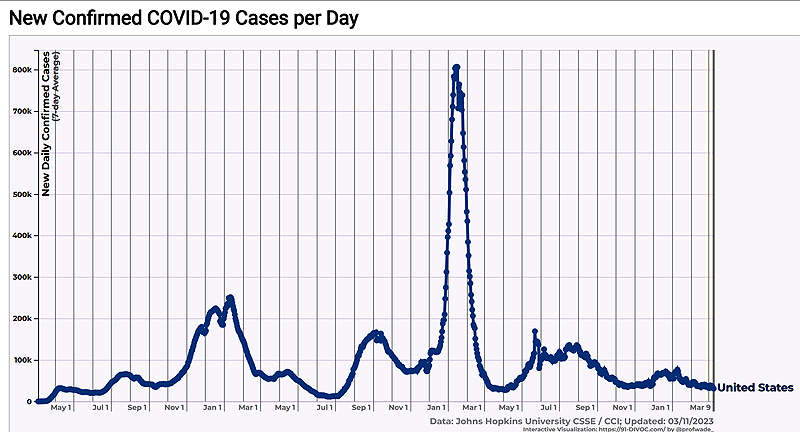
It is now three years since America's
"last normal day," the day the COVID pandemic changed our lives.
Are we back to normal yet? No, and I think we never will be, just as life after World War II
never returned to the status quo ante. At this point, though, we are not yet in any kind
of postwar boom either; it's more like the unease of 1946 or 1947. Where are we?
Perhaps the most surprising thing about the plague years, for us, is that they were not a time of leisure.
I suppose they may have been for some people.
But the change to our daily routines was less than most people's.
Because of chronic health problems, Melody and Sharon were already accustomed to being at home
most of the time, and my consulting business often involved working from home,
so we didn't have a lot of settling in to do.
The reason for the lack of leisure was mainly a torrent of controversial information and events to keep up with.
We spent a lot of time simply finding out what was going on, then trying to guide others
to think about it rationally.
In fact, I think that was one of my major civic duties — simply participating in online discussions and
often reaching thousands of people. It took a lot of time.
We had bitter controversy about the pandemic itself, and then a hard-fought election followed by
a violent attack on the Capitol whose consequences are not finished playing out.
Throughout all of this, the nation was plagued by
weaponized foolishness, deliberate
misinformation and manipulation. For example, "fake news" quickly came to mean not "false reporting"
but rather "news a person in power doesn't like."
Newsweek recently pointed out that the lockdown and related measures were adopted very quickly
with less than the expected amount of discussion. The medical community closed ranks behind Dr. Fauci
before we had had the discussions that might have given us better policies.
I noticed that at the time, but Newsweek didn't point out the obvious reason:
there was such an upsurge of quacks and cranks that the medical community had to unite against
a common enemy.
That was the era of "Ya gotta watch this video,"
and I had to hammer home repeatedly the point that it doesn't matter if your video can
convince me, the question is whether it convinces people who really know the subject.
Too many untrained people thought they were experts, and there were jokes about "Facebook School of Medicine."
Part of the problem is that Americans weren't ready for Internet news, social media, or even
hundred-channel cable TV. Back in the days of Walter Cronkite, the FCC enforced a Fairness Doctrine
that strongly encouraged newscasters to stick to hard, verifiable facts, not matters of opinion.
The reason was that it was only technologically possible to deliver two or three TV channels to most places,
and nobody wanted the whole country to be misled by a gigantic partisan news source.
I'm not sure the Fairness Doctrine was entirely consistent with American principles, but it did keep down quackery.
There was a widespread feeling that the media favored the Democrats, but only mildly.
Indeed, news inherently favors those who are proposing change rather than opposing it,
simply because they make more news.
The point is, we had a public that didn't know how to weigh sources of information and easily
got Balkanized into "social-media bubbles," communicating only with people who held the same
extreme opinions as themselves. I saw some of the insanity start to lift when people got back to work
and had to associate with colleagues who didn't share their positions.
Let me be clear that you have a right to hold controversial opinions (I have some myself)
provided you're well-informed and understand why not everyone thinks the same way
(and that you're intellectually honest — delusion or manipulation is not your goal).
But during the plague years, a lot of people showed us that they hardly know what information is,
choosing to live in an imaginary world or believe things just because they can say the words.
Sadly, I lost a few friends (one of whom went all the way to QAnon, last time I heard).
Also, I wonder whether anyone lost jobs. If you reveal publicly that you don't have any sense,
that you can't weigh sources of information and will follow any manipulator who comes along,
then will people trust you in a position of responsibility? What if the voices in QAnon's head
say to sabotage your employer's computer?
Apart from all the controversies, a sad thing happened to our social life. Fortunately,
we had social media to stay in touch with friends. Unfortunately, this tended to turn into a clamor,
with lots of people demanding immediate attention. Intense discussions were easy to have, but not
the casual interactions that make life enjoyable.
I've written several times about how my worst regret was how we would lose, not close friends, but
the casual contact with people we see at work, school, church, or in the marketplace, and whose
presence brightens our lives, but whom we don't know well enough to seek out socially. For shy people like
Melody and me, a congenial crowd is almost more important than a circle of friends.
And as normal life resumes, there has been three years' worth of attrition and turnover.
We don't know how many people and places from before COVID we will never see again.
There's even the question of friendly interaction with strangers.
A couple of years into the pandemic, as the University
was starting to return to normal, I went to the library, held a door open for a young girl, received
a smile and a "thank you," and realized: That's what I had been missing. I told Melody that of course
I don't go to the library to flirt with the college girls, but I had really been missing the kind of
interaction where people are kind to each other in tiny ways and acknowledge it, simply as members
of the human race, without any relationship or obligation.
People who want us to do things are still readily at hand — thanks to social media, more than ever —
and what we have lost is the presence of people who don't demand our attention.
The other big difference is that we don't travel much. Melody has been to Kentucky once to
see the grandchildren; I haven't. Our habits changed, and even though it's not really restricted, we don't
even get to Atlanta very often. One reason is of course that shopping has declined; we have local
suppliers of necessities, but there is no serendipity, and going to Atlanta doesn't get us anything we
don't have locally.
I'm not sure how to get back closer to normal life.
Because of the abundance of remote work, social media, and electronic communication, I've noticed
people treating others almost like buttons on a computer screen — I send you a message and
you're supposed to do something instantly — the pace of human interaction is lost.
Of course, there were such people even in the 1960s; I remember avid users of the telephone
who thought everyone should be ready to drop everything and talk to them at any time; but now we have
something I think we need to actively counteract. Take time; go from place to place; give people time
to collect their wits; and enjoy the presence of people who are neither sources nor recipients of
urgent requests.
Permanent link to this entry


|
2023
March
5
|
Competing astronomical cameras

(Information has been added, in blue type.)
Which of these images was taken with the best camera?
Never mind that the one at the upper left is a tiny bit out of focus.
That's not what we're comparing.
We're looking at the sensitivity and noise level of the sensor.
Also, please disregard the fact that the image scale is about 15% smaller
in one of the images.
These are matched sets of ten 30-second exposures at f/4, processed in the
usual way, including color correction, and automatically stretched to look alike.
(I hope your answer was that you couldn't see much difference, if any, in the sensor
performance. They are not all equally well focused, of course, but I can't see any
definite difference in noise or sensitivity.)
Tomorrow I'll come back and tell you what cameras they were taken with.
Upper left, Canon 60Da at ISO 640;
upper right, Nikon D5500 (H-alpha modified) at ISO 200;
bottom center, Nikon D5500 (H-alpha modified) at ISO 640.
It's surprising that they look so much alike.
The Canon sensor has appreciably more noise than the Nikon.
The noise levels in e- are: Nikon at 200, 2.8; Nikon at 640, 2.3;
and Canon at 640, 3.2.
But the pictures look alike.
What's going on is what
Robin Glover has pointed out at length:
at a reasonable exposure level, the shot noise from the sky background or
baseline level is much greater than the sensor noise.
The Canon sensor is a second-generation one; newer Canons are better;
and on other tests the Canon looks a lot worse than the Nikon.
The sensor in the Nikon is better. But the Nikon also does not deliver a
truly raw image; cosmetic correction is performed on it before it is
delivered. So are some other corrections that can disrupt astrophotos.
The Nikon does have appreciably better dynamic range. The photographic dynamic range
of each camera, according to www.photonstophotos.net,
is: Nikon 200, 9.67; Nikon 640, 8.09; Canon 640, 7.61 (each measured in stops, or log2 range).
A big dynamic range is a sign of a low-noise sensor — that's why we pay attention to it —
but when we stretch an image during processing, we usually throw away three quarters of the dynamic range
in order to amplify faint detail. Astrophotos are normally underexposed (or else very low-contrast)
until processed.
So... where is this leading? I've gotten great astrophotos with the Nikon, but if,
knowing what I now know about how to use it best, I can get the same results with
the Canon, I'll switch back to it, because it's free of minor quirks and generally a bit
easier to use for astrophotography.
Stay tuned. I may try the Canon a few more times and conclude the Nikon beats it hands-down;
or I may conclude the greater ease of use is worth a tiny decrement in quality, which I can
make up in processing. We'll see.
Permanent link to this entry
M78 in moonlight
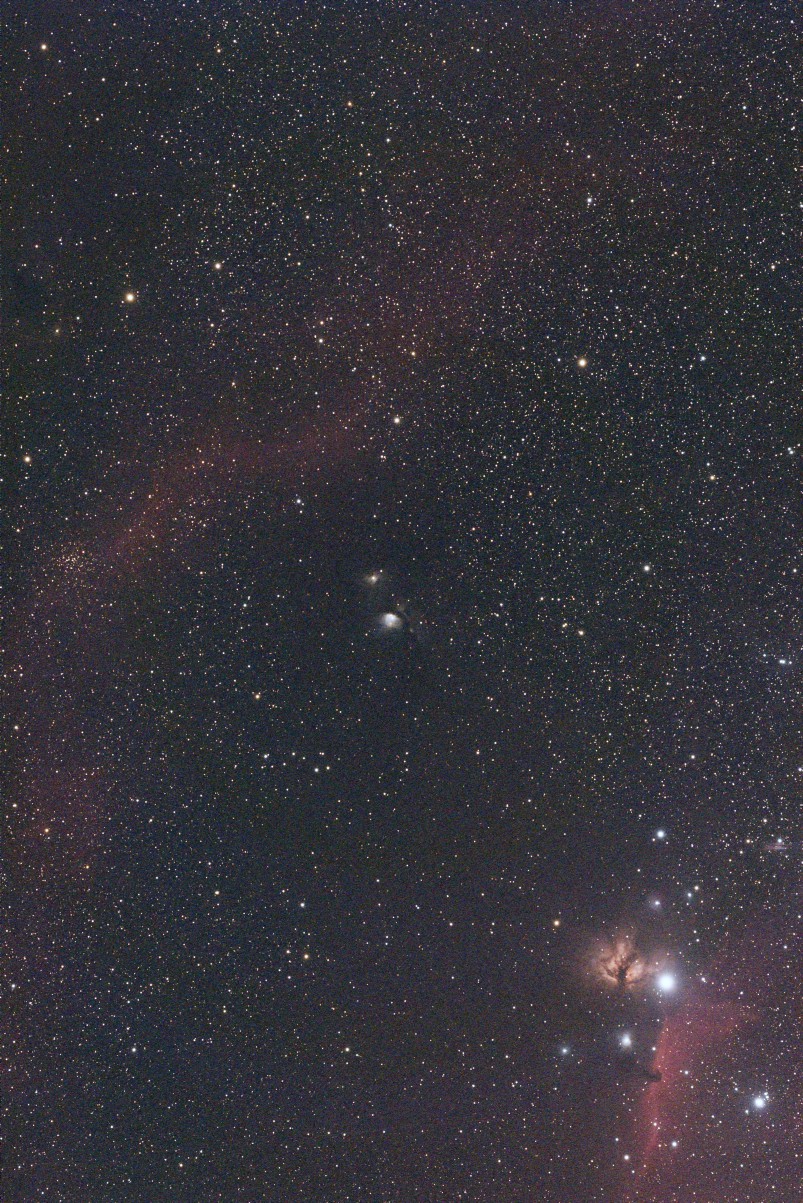
It was an equipment-testing session, but I don't like to come back empty-handed, so
here's an image centered on the reflection nebula M78, with some of the other
sights of Orion visible elsewhere in the picture.
Stack of ten 2-minute exposures, Askar 200-mm f/4 lens and Nikon D5500 (H-alpha modified),
in bright moonlight.
Permanent link to this entry


|
2023
March
1
|
John Granrose, 1939-2022
For some reason I was not getting the news in late November, and the
deaths of two friends only came to my notice just now.
Word has just reached me of the death of
my undergraduate teacher, and, in later years, next-door neighbor John Granrose.
I took his honors course in Philosophy of Ethics at the University of Georgia,
as best I recall,
some time during the 1974-75 academic year.
The main concern of the course was not whether particular acts were ethical, but rather,
the nature and logic of ethical obligation.
From that course I got the valuable distinction between
utilitarianism and deontologism
(see also this)
that I have found so useful for elucidating political disputes.
My term paper for the course was a review of Fletcher's Situation Ethics,
a book often credited with "introducing the New Morality" although that's not quite
what it did. I contended that all ethical judgments are about "situations,"
and Fletcher did not actually have a new system of
ethical reasoning, just an assortment of moral judgments that were different from
other people's and needed further analysis. (He said it could be right to do anything
if motivated by unselfish love. I saw that as mere emotivism.) I don't know if I was
right; in later years it struck me that Fletcher may have been groping for the
defeasible deontic logic later developed in a very
technical way by my UGA colleague Donald Nute. Anyhow, I learned a lot.
A few months later, John was one of the speakers at the
UGA Honors Program event
where I met Melody.
He was not actually present when we met, but he was the last person we were in
contact with who had definitely attended the event
(unless one or more of our friends were there singing in the Glee Club; we're not sure).
As a panelist for the Honors Program, he told a funny story which I will recount,
although I'm sure he did not originate it.
"Philosophy is about keeping things in perspective," he said, and as an example
of perspective, he quoted a letter supposedly written by an undergraduate girl
to her parents.
It described a series of calamities, "and then the dorm burned down. Fortunately, the
kind person who took me in was very helpful. He's not exactly a Communist, more a
practicing socialist..." (Remember, this was 1975.)
"P.S. None of this actually happened. But I did get a D in one of my courses, and C's
in two others, and I wanted you to put that into perspective."
After I returned as a faculty member, I knew him as a colleague, and a few years ago
he and his wife moved into the house next door to us.
We had some good visits and learned that John was famous, not only for academic
philosophy, but also as an expert on Jungian psychology and as a stage magician
— he observed that the latter two were both applications of the study of cognition.
Just a few years ago the Granroses moved to Yorkshire, England, and that is where he
spent his last days. Lux aeterna luceat ei, Domine, cum sanctis tuis in aeternum.
Permanent link to this entry
Roy Green, 1956-2022

The other death I just heard about was that of Roy Green, who was my contemporary as a student
at UGA — he said he knew who I was at the time, but I can't be sure I knew him — and,
later, UGA computer services colleague before he moved to other employers.
We reconnected (again) through Facebook in recent years.
A lifelong bachelor, Roy faced failing health in the company only of a few local friends in Atlanta,
and because other records of him are likely to be scant, I hope no one minds if I reproduce
his picture from Facebook.
In his student days Roy had been active in WUOG-FM (the campus radio station) and was an avid
photographer. Without actually knowing each other then,
he and I moved in very simliar orbits and must have known a lot of the same people.
In later years we've exchanged memories of
things as récherché as Star Photo No. 1 in Atlanta
(where Melody also recalls going as a little girl;
it was an unusually well-equipped camera store and is opposite a famous Krispy Kreme
doughnut shop). During my absence from Athens c. 1980, Roy
himself had worked in the Alan's camera store at Georgia Square Mall.
In our UGA student days, he was apparently occasionally at University Church, as was I, and we had
some acquaintances in common. Because of his ongoing interest in music, he numbered among
his friends my Valdosta classmate, the musician Sue Wilkinson. And in recent years, via
online conversations, he helped
fill in my knowledge of the development of rock music.
He also had a lifelong avid interest in model rocketry.
My first clear memory of Roy was from when Melody and I were living in California, early in 1984,
getting ready to move to Athens, Georgia,
and made a few calls to a BBS in Athens to start connecting with the local
community of computer enthusiasts.
(A BBS was a pre-Internet online forum, hosted by a single PC, to which users would have
to make long-distance phone calls with telephone-line modems.)
Roy told me about his job at UGA and we found out we'd be working in the same building.
He was also active in the Athens PC Users' Group.
Later, he moved to Atlanta, and we lost contact, then regained it via Facebook.
May his memory be eternal.
Permanent link to this entry
UGA athletic recruiter kills student
If a UGA athletic recruiter murdered a football player — with help
from another football player — how would we feel about it?
Well, that's basically what happened on January 15.
The police report came out today. A Ford Explorer crashed at 2:30 a.m., killing its driver, Chandler LeCroy,
and a football player, Devin Willock, who was sitting behind her. Two other passengers survived.
According to the report, the driver, a 24-year-old woman, was a UGA athletic recruiter, and had a blood
alcohol level of 0.197, two and a half times the legal limit. She was racing a vehicle driven
by Jaden Carter, another football player.
This is not a borderline case — everyone must have known she was drunk.
And racing at over 100 mph is not something you do accidentally.
Drunk driving is a shameful way to die and an even more shameful way to kill someone else.
Let's call it what it is — a crime.
If the driver had survived, she would be in prison.
There are questions to be asked about exactly what a "recruiter" is — a hired party girl?
But above all, we've got to combat the notion that when you're "partying" or when you're
among football stars, normal real-world responsibilities somehow vanish.
This is a very sad event. Let's not have any more of them.
[Note added:]
A friend asks the very pertinent question,
"What kind of culture are we creating?"
As far as we can tell, an Athletic Association employee used an Athletic Association vehicle
to take football players to a strip club, drink heavily, and then go racing.
We need to be asking about all the other people, near or far, who encouraged this
or failed to discourage it, ranging from people present at the bar
(who could have said "you're too drunk to drive"), to the recruiter's supervisors and job definition,
to the overall "party culture" and expectations.
And the people who, in contemporary chit-chat, are telling other people not to criticize aspects of this.
Permanent link to this entry
N.I.N.A. with a DSLR
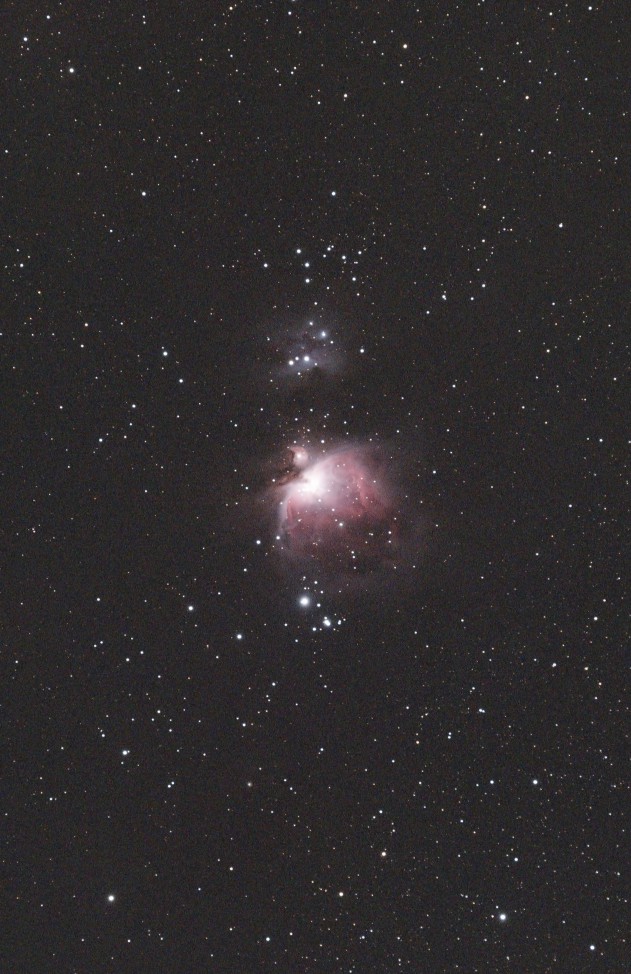
I am glad to report that the free
N.I.N.A. software package
(which I will henceforth call NINA, for ease of typing)
works well with my Nikon D5500.
I am easily able to focus in live view mode (magnifying single pixels into
quite visible blocks), though focusing requires a bright star.
Setting up an exposure sequence, aiming the telescope, plate solving to confirm position,
and taking the pictures all goes very smoothly.
I confirmed this last night with my Losmandy GM811G, Nikon D5500, and Askar 200/4 lens.
(I had just gotten NINA working with my iOptron mount when I decided to change mounts
in midsummer last year, and I dropped back to simpler software while getting used
to the new mount.)
I did have to set my small laptop to 1366×768 resolution, as 1240×720 was
not quite enough for NINA to be comfortable.
Unfortunately, I didn't have a very successful photo session, for a totally
irrelevant reason.
The mount had somehow lost its PEC training, and I didn't have a guidescope set up,
nor realize that I needed to.
The goal of the session was to try out equipment and software, not to photograph
anything specific.
Nonetheless, I didn't come back empty-handed. The picture above is a single 2-minute exposure of the
Orion Nebula; 200-mm f/4 lens wide open; Nikon D5500 (H-alpha modified); calibrated
with darks and flats; and deconvolved to make up for imperfect tracking.
This is a quite unremarkable picture, but the Orion Nebula is splendid in even
a modestly good rendition.
Permanent link to this entry


|






